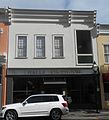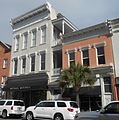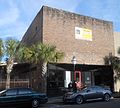William Aiken House And Associated Railroad Structures
Description and history
The historic district has three distinct sections. The main section is bounded by Mary, King, Meeting, and John Streets, north of Charleston's historic downtown area, and includes the Aiken House, surviving elements of the main railroad depot, and associated warehouses. A second, smaller area is located on the north side of Line Street, between King and Meeting Streets, where the company's railroad car repair and refurbishing facility was located. These two areas are joined by the former railroad right-of-way, which is still readily discernible in most of the blocks between them.
The Aiken House is located at the corner of King and Ann Streets on the west side of the main section. It is an 1807 Federal Adamesque wood-frame house, two stories high, with a two-story porch extending across its southern facade. It is where the South Carolina Canal and Rail Road Company was founded in 1827, with William Aiken, an Irish immigrant, as its first president. Construction of the railroad line took place between 1830 and 1833, marred by the death of Aiken when horses drawing his carriage were frightened by construction-related noises, overturning it, and also by the explosion of the Best Friend of Charleston, the first American-made steam locomotive. When it began operation, it had the greatest length of track (136 miles (219 km)) in the world under single management. In 1929, the Southern Railway, which had taken possession of the house with its acquisition of the South Carolina Canal and Rail Road Company, removed several decorative elements such as a fireplace mantel from the Aiken House and used them in the executive offices of the Southern Railway Building, its Washington, D.C. headquarters.
There are two principal depot buildings in the district. The "Camden Depot" stands on John Street, and the "Tower Depot", now little more than a pair of crenellated towers, stands on Mary Street. These two buildings were completed in 1850, and in the area between, two warehouses were built in the following decade. The depots and one of the warehouses are architecturally distinguished by their Gothic Revival features, which are not frequently found on railroad infrastructure. The Tower Depot, which was the railroad's original passenger depot, was only used until 1853, when a through depot was built near Line Street. In 1857, the large brick Italianate car shop was built adjacent to the main railroad line just north of Line Street.

Contributing buildings
- William Aiken House, built in 1807. An octagonal wing added in 1831 but damaged in 1886 earthquake, and certain woodwork was removed in 1931. A servants wing is unchanged.
- A coach house at the back of gardens on the William Aiken House property
- Camden Depot, a railroad depot
- Deans Warehouse, built in 1856
- South Carolina Railroad Warehouse
- Tower Passenger Depot
- Line Street Car and Carpenter Shops
- Railroad Right-of-Way
- "Best Friend of Charleston" Replica, a replica of the first American-made steam locomotive
Non-contributing structures in the district include:
- Hughes Lumber Company Warehouse and Martshink Beer Warehouse
- Shed housing the "Best Friend of Charleston" replica locomotive
- Buildings along John Street, King Street and Meeting Street:
- Chicco Apartment Buildings A and B
- 39-4, 39-B, 39-C John Street
- 41-B, 43, 51 John Street
- numerous buildings in 424-492 King Street
- Brick building at Meeting Street and Ann Street
- Lilienthal's Stained Glass
- 365-371 Meeting Street
Gallery
-
426 King Street
-
434 King Street
-
436 (right) and 438 (left) King Street
-
464 King Street
-
466 King Street
-
A replica of the Best Friend of Charleston engine and tender are loaded on a truck for transport to Norfolk Southern in Atlanta – August 6, 2007.
See also
- Gov. William Aiken House, home of his son
- List of National Historic Landmarks in South Carolina
- National Register of Historic Places listings in Charleston, South Carolina
References
- ^ "National Register Information System". National Register of Historic Places. National Park Service. January 23, 2007.
- ^ "William Aiken House and Associated Railroad Structures". National Historic Landmark summary listing. National Park Service. Retrieved February 12, 2008.
- ^ James Dillon and Cecil McKithan (May 12, 1981). "National Register of Historic Places Inventory-Nomination: William Aiken House and Associated Railroad Structures" (pdf). National Park Service.
{{cite journal}}: Cite journal requires|journal=(help) and Accompanying seven photos, from 1961 and 1975 (32 KB) - ^ "William Aiken House and Associated Railroad Structures (456 King St., Charleston)". National Register Properties in South Carolina listing. South Carolina Department of Archives and History. Retrieved March 21, 2008.
- ^ Spinner, Jackie (January 2, 2002). "A storied building; law firm finds historic home". The Washington Post. p. D11.
External links
- William Aiken House website
- William Aiken House and Associated Railroad Structures, Charleston County (456 King St., Charleston), including 13 photos, at South Carolina Department of Archives and History
All of the following Historic American Buildings Survey (HABS) records are filed under Charleston, Charleston County, SC:
- HABS No. SC-373-A, "South Carolina Railroad-Southern Railway Company, 456 King Street", 31 photos, 2 data pages, 3 photo caption pages
- HABS No. SC-373-D, "South Carolina Railroad-Southern Railway Company, Carriage House, 456 King Street", 2 photos, 2 photo caption pages
- HABS No. SC-373-B, "South Carolina Railroad-Southern Railway Company, Camden Depot, Anne Street", 4 photos, 2 photo caption pages
- HABS No. SC-373-C, "South Carolina Railroad-Southern Railway Company, Warehouse, 42 John Street", 1 photo, 1 photo caption page







